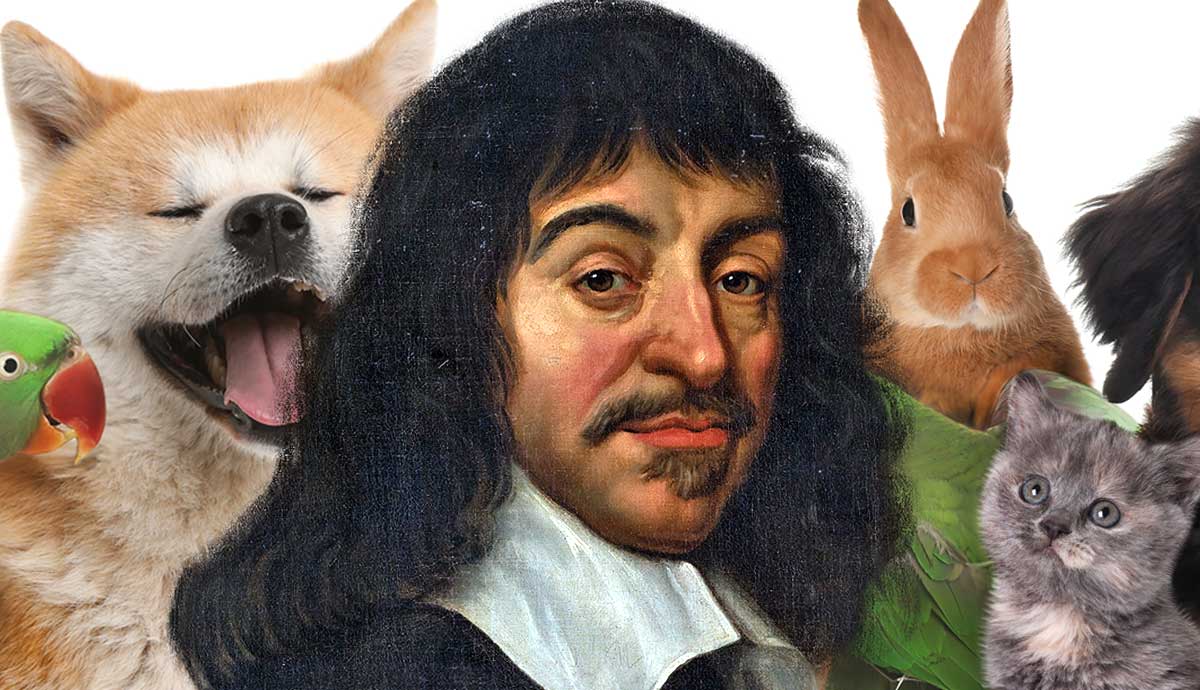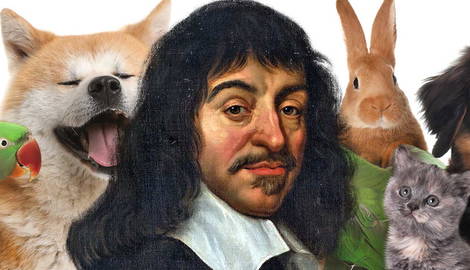
Having divided human beings into two parts—the “thinking thing” (res cogitans) and “extended thing” (res extensa)—René Descartes (1596-1650) became the father of dualism. However, he also introduced a mechanistic view of other beings, most notably non-human animals. This changed the course of philosophy of mind, which rested on the assumption that we are fundamentally unique, unlike those nasty beast machines. So, if beast machines can’t feel anything, why not use them as subjects? Let’s unpack this Cartesian curse.
A Crash Course on Dualism

Any proponent of dualism has to claim that mind and body are essentially different things or substances. This leaves enough room for the idea of an immortal soul, which helped Descartes to avoid being called names (like “heretic” or “a blasphemous guy sitting in his little armchair thinking he is better than all the other Sorbonne professors”).
Unfortunately, this also leaves enough room to cast a curse on anything non-human (and, coincidentally, whose name begins with the letter “a”): automatons, angels, and animals. Automatons and animals are bound to their bodies, which are mere mechanical devices. Angels, on the other hand, are unsullied res cogitans despite what Renaissance paintings tell you. Let’s hear it from Descartes himself:
“I desire, say I, that you would consider that these functions all follow naturally in this machine solely from the disposition of its organs, neither more nor less than the movements of a clock or other automaton [follow] from those of its counterweights and wheels, with the result that it is not at all necessary to conceive for their operation any other vegetative or sensitive soul in it or any other principle of movement and life than its blood and spirits, agitated by the heat of the fire which burns continuously in its heart and is in no way of another nature than all the fires that are in inanimate bodies.” (Oeuvres de Descartes 11: 202).
Thus, dualism became coupled with animal automatism, the position according to which non-human animals are akin to mechanistic devices like clocks (yes, that includes your smartwatch).
Consequences of Animal Automatism

The implication of this view was that the treatment of such beast machines does not have to reflect the treatment of human beings. It would certainly be wrong to cut the tendon of a random person (unless you somehow end up in the middle of a dark street on St Bartholomew Night and you happen to be a French Huguenot). This is because they can feel the sharp pain and then cry upon seeing their blood pouring from the wound.
On the other hand, break a clock and see what happens. A lot of screws and tiny parts with complicated names will end up on the floor, but the clock doesn’t cry. It squeaks.
Another important thing to note here is that the wounded person can tell you what hurts him or, more likely, utters a whole bunch of slurs. The squeaking of the clock has no meaning, and it is not language. The beast machines have no language capacity, while we do. The language is the watermark of our uniqueness—we are such a convenient combo of res cogitans and extensa, and we can speak. By speaking, we show that we have reason. Beast machines don’t have it. Simple as that.
Vivisection: The Cartesian Way

Descartes himself performed vivisection on non-human animals. This may sound really terrible (and it was), but bear in mind that this was a standard procedure in ancient Galenic and medieval medicine as well. The only components of behavior that we shared with non-human animals were automatic, like reflexes and convulsions. The vivisection served to learn more about us, so nobody found anything particularly controversial in its performance. After all, it was the Age of Modern Science.
The tacit assumption here is that we and non-human animals are similar in terms of our organs and are capable of self-induced movement. These easily observable facts for a skilled anatomist made Descartes change his mind slightly. Non-human animals do have something besides mechanical screws and parts with complicated names—a flow of “spirits” produced by the heat of their hearts (Oeuvres de Descartes 7: 230). They may even be granted a specific kind of soul, dependent on the movement of spirits and the existence of the heat on the inside (Oeuvres de Descartes 5: 276). This makes Descartes look slightly better.
Although we don’t know whether Descartes had a guilty conscience while performing vivisections on the squeaking automata with a specific kind of soul, we do know who hadn’t – Nicholas Malebranche (1638-1715). A Sorbonne student and a fervent follower of both Descartes and St Augustine, Malebranche sought to forge a tighter link between our intellectual capacities and God.
Thus, for Malebranche, God had put all ideas and ethical principles in our minds, meaning they are universal and objective truths. In other words, all instances of our goal-directed behavior are managed and inspired by God. If God made me cut someone’s tendon, then He must have known that I was corrupted in my soul and lacking the capacity to comprehend ethical principles. What am I to do then? Repent and feel guilty. However, if God made you perform a vivisection on a test animal, you have nothing to worry about.
Given that it is a pure mechanism, such a creature has no capacity for goal-directed behavior. Moreover, being a mindless mechanism, it cannot suffer or feel anything. This is why a Cartesian like Malebranche would claim that our ethical principles do not apply to the treatment of non-human animals, thus justifying experimental methods like vivisection.
The Cartesian Curse: To Degrade a Human Being Is to Call It a Lower Animal

Another Cartesian philosopher who was not fond of Malebranche (even though he shared his conviction that Descartes’ philosophy was worth developing) was Antoine Arnauld (1612-1694). He also had little to say about non-human animals. Nonetheless, what he did say followed the usual Cartesian line of comparing superior humans to inferior natural automatons.
Arnauld disagreed with Malebranche’s view that human actions were caused by both God and natural laws—natural laws being merely occasions for God to exert his causal powers onto us. To consider human free will dependent on anything but God amounts to degrading human beings. Why? Well, because only lower animals, in Arnauld’s opinion, are liable to the whims of nature, whereas we are the ones who choose not by necessity but out of freedom and by God’s grace.
Stagnation in the Philosophy of Mind

We can summarize the three main differences between us and non-human animals that further served to carve in stone our privileged place in nature:
- The capacity for language and intellectual capacities in general;
- The capacity for morality, which naturally aligns with ethical principles that regulate our social relationships;
- Choosing to act based on free will rather than instinct.
Nonetheless, we are still left with relevant similarities in terms of bodily structures and functions. The next step involves rationalizing almost any way we treat non-human animals if it helps us better understand our biological advantages or fix any innate or acquired disadvantages. And just like that, animal testing has become a go-to method for natural philosophers of the Early Modern period and Enlightenment.
As a result, the philosophy of mind became short-sighted: the solution to the Cartesian mind-body problem, which concerns how the mind and body interact, was sought within the human brain or the soul.
Famous examples include:
- Robert Boyle’s experiments on whether non-human animals rely on air for survival;
- Antoine Lavoisier’s combustion experiments on guinea pigs;
- Luigi Galvani’s investigation of the relationship between electricity and animation through frogs.
This led to more advanced medical and psychological experiments in the 19th century. Superior humans thus embarked on uncovering secrets about their minds and bodies by examining the mechanical aspects of creaking natural automata without paying much attention to the significance of those creaks. Thank you, René.
Turning Away From the Cartesian View of Non-Human Animals

Peter Singer has labeled the historical bias that considers animals to be inferior to humans as speciesism. This label should convey the idea that belonging to a particular species is not a morally relevant property. Rather, all beings affected by someone’s action deserve to have a moral status. Therefore, animal testing can’t be justified by simply saying that non-human animals are merely extended things and have no mind.
Nonetheless, thinking about minds other than our own takes a great deal of boldness. Philosophy of mind, grappling with the schism between dualism and physicalism, has long been in a stalemate. Philosopher Thomas Nagel cracked open Pandora’s box with the now famous question: “What is it like to be a bat?” Nagel argued that while we can describe a bat’s behavior, we cannot truly know what it feels like for a bat to experience the world through echolocation. This highlights a fundamental gap in our understanding of the minds of non-human animals.
Due to their deeply subjective nature, they may remain forever beyond our scientific grasp. In other words, not only is the Cartesian view of non-human animals as natural automata far from true, but we may be unprepared to understand them inasmuch as we struggle with understanding ourselves.
References
Adam, C., & P. Tannery (eds). 1996. Oeuvres de Descartes (11 vols). Paris: Vrin.
Nagel, T. 1974. What Is It Like to Be a Bat? The Philosophical Review, 83 (4), pp. 435-450










